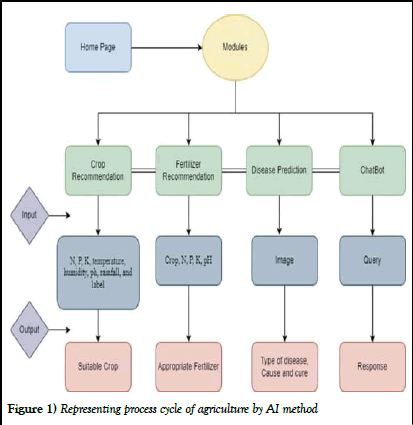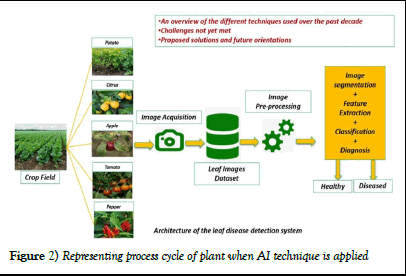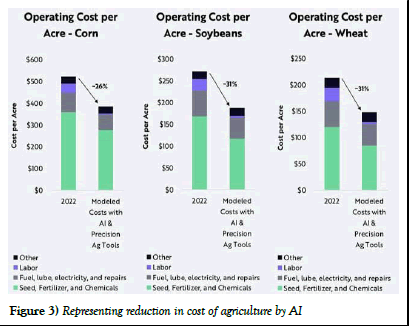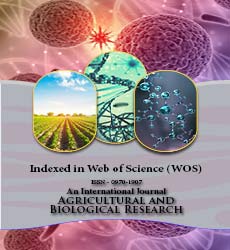Agricultural and Biological Research
RNI # 24/103/2012-R1
Research Article - (2025) Volume 41, Issue 5
The integration of AI in agriculture extends to autonomous farming equipment, where smart machines powered by AI algorithms handle tasks like crop monitoring, plant phenotyping etc. AI technologies, such as machine learning and computer vision, enhance precision farming by optimizing resource usage, crop monitoring and decision-making processes. These innovations contribute to increased efficiency, sustainability and yield in agricultural practices. However, challenges like data privacy, cost effective and ethical considerations remain. In these paper different techniques using artificial intelligence is reviewed and their efficiency is recorded.
Phenotyping; Percission agriculture; Hyperspectral imaging; Lidar; IOT
The amount of organic matter and total amount of nitrogen in the soil matter plays very important role in soil fertility and its health. These two things affect the physical, biological and chemical properties of the soil. Hence, it is necessary to check if the organic matter and nitrogen is available in satisfactory amount throughout the field. There is one way to take the sample of soil to the laboratory for proximal reflection spectrometry and imaging spectrometry which assess the soil quality and its properties [1]. But the lab tests are not reliable to get an overview of the nutrients’ continuous distribution over a specific area. To tackle this, hyperspectral imaging spectrometry is used to get the data of soil organic matter and nitrogen content over a certain targeted geographical location. It uses hyperspectral sensors’ data from satellites, planes and UAVs [2,3]. Researchers have used the dataset for their projects available from the satellites’ sensors. EO-1 Hyperion satellite’s sensor data is not recent (the data available is till 2014) which makes it not a first choice for recent development in soil properties estimation [4,5]. For new data, GF-5 AHSI data is being used but, satellite based HIS methods will not give accurate results for small-scale application like fruits plant [6-7]. It will be a good choice for covering larger areas. The alternative to satellite based is airplane and UAV based. The airplane based were an ideal choice until UAVs started being used due to its obvious advantages over airplanes like not regulated by air traffic control, cost effective and flexibility
UAVs have been used mostly for classification and mapping functions in precision agriculture. The techniques through which mapping of the field can be done is either passive or active remote sensing. Active remote sensing is (LIDAR) and passive is nothing but optical remote sensing. UAVs can be used for
The above Table 1 represents the review and limitations of the research conducted by different authors from the above mentioned Table 1 we can observe that the different technologies used from planting to harvesting while few of them is budget friendly while few are bit costly.
| Author | Year | Study type and application | Methodology | Limitation |
| Faical | 2014 | Research: Spraying | An algorithm was developed to maintain the course of the UAV. When spraying the pesticides in the field with the help of data from WSNs. Instance-based and density based used for building the maps of the field a 14% improvement in the spraying was observed when message was sent every 10 seconds. (Xbee pro for communication between WSN and UAV. | WSN was quite expensive and its design for low speed application which was delaying the action. |
| Faical | 2017 | Research: Spraying pesticides | This study was the further work by the same authors mentioned above. The algorithms were improved keeping environmental parameters like wind in mind, genetic algorithms, swarm particles optimization, simulated annealing and hill climbing technique were analysed to optimise route change of UAV during spraying | It was able to overcome the speed but the cost of implementing was increased which was not possible for everyone to utilise it. Especially to the poor farmers |
| Zhu | 2021 | Research: Maize phenotyping | Multiple UAV systems were utilised for 5 phenotyping methods on maize crops, hyperspectral imaging, LiDAR, thermal and RGB The phenotyping included crop biomass index, plant moisture, crop height, leaf chlorophyll and leaf area index. The data acquired by UAV sensors were/ then processed by machine learning techniques like back propagation Neural Network, random forest, multi-variable Linear Regression (LR) for modelling. Three detailed conclusions were made after the experiment was performed | Large area of farming is required as multiple UAV are used and hence group of farmers or union is required. Cost of operating and implementing will again be high |
| Comba | 2020 | Research: Vineyard phenotyping | Another multiple UAV system (6) was developed on the field for gathering aerial images of the vine for evaluating leave area index. The crop canopy descriptors were calculated by 3-D point cloud processing algorithms. The results of the UAV and machine learning based leave area index was an adequate as the result is taken by manual method | Large area of farming is required as multiple UAV are used and hence group of farmers or union is required. Cost of operating and implementing will again be high |
| Saha | 2018 | Research: Crop quality improvement | Components like RGB D depth camera, thermal camera used to develop a system on UAV for improving farming drone. The data gathered from various sensors was classified with support vector machine-based ML algorithm and was tested for plowing process. | Capable for few special type of farming only |
| Boursianis | 2020 | Review: IoT and UAV in agriculture | The author compiled a comprehensive review literature on IOT and various sensors in farming and in the second part of the paper, a detailed study of the usage of UAVs in agriculture has been carried out. The information on application of both the technologies in agriculture is precise and can be easily understood with the help of graphs and tables. At the end of the paper, a proposed project called a AERThOU5A has been included. The author concluded that discussion with the commenting, UAV and IOT technologies can bring a new era in agriculture | Specially trained people are required to operate the complete system |
| Feng | 2021 | Review: UAV remote sensing for crop phenotyping | This review was focused on specific application of crop phenotyping using UAV based sensors. Different sensors mounted on the UAV, their application and related usage in any particular experiment has been nicely explained by the authors. The paper explains various crop, phenotyping characteristics like plant heights, leaf area index, biomass etc. and how researchers over the time has classified the characteristics with the help of UAV cameras, Challenges, future works, any confusion second section briefly discuss some the overall summary and problems faced by the method. |
Help in phenotyping but the other factors like quality of soil and pesticides and water requirement cannot be overcome |
TABLE 1 Research gap/limitation
The another issue is that in order to operate the tools proper training is required to farmers as otherwise it could show the worse effects if not handled carefully.
It is evident from the case studies mentioned above that AI has crucial role to play in the applications like Irrigation, yield management, pest and disease control etc. The applications can be categorised as field applications, environmental and agricultural. With the advent of the artificial intelligence, over the years, many new methods have been devised to make the problem solving as easy as possible.
Many of the papers discussed above used AI techniques in one way or another. The subset of the AI is machine learning. The data (statistical o experimental) from the past is fed to the machine to train it and the purpose is to solve any application specific problem.
Some of them are listed below.
Various fruit images like apple, guava, kiwi, lemon, cherry etc. were taken in the dataset. Images will be selected and passed through the custom model designed by the researchers. A new method of including pooling layers to the neural networks differs this method from other implementations in the field. The designed model will get 97% accuracy with 19.5 milliseconds. The problem of background information in the crop images interfering the accuracy of the system.
To tackle that, an automatic image segmentation algorithm was developed based on Grab cut algorithm [8]. For deep learning model, mobile net based on CNN was chosen. This algorithm basically removes the background (unnecessary) information (noise) from the crop images and let the model focus on the problem (In this, crop disease identification) [9]. A huge dataset of 38,072 images with 22 diseases from 6 crops were taken and fed to the model. The system was then taken to the smart mobile devices in which the customer can get disease information with accuracy of 84.8%.
All together a high quality micro camera is attached on UAV (drone) which will send its images and spray the color at particular place where the diseased crop or fruit is found the camera on drone is connected with the smart mobile and it will also check the phenotyping of the crop and area where the color is sprayed the farmer could target those area and spray the pesticides or provide water where it is required [10].
The widespread implementation of Artificial Intelligence (AI) in agriculture has shown significant results, providing numerous benefits to farmers and the overall agricultural industry. Some notable outcomes include:
Increased crop yields: AI algorithms can accurately predict crop yields based on various factors such as weather conditions, soil quality and historical data. By utilizing these predictions, farmers can make informed decisions regarding planting techniques, resource management and crop rotation, resulting in improved yields.
Enhanced crop health management: AI-powered systems can analyze images of crops taken by drones or sensors to detect early signs of diseases, pests or nutrient deficiencies. This early identification allows farmers to take prompt actions, preventing the spread of infections and reducing crop losses.
Optimized resource allocation: AI algorithms help farmers optimize the use of resources like water, fertilizers and pesticides by providing precise recommendations based on specific crop needs. This reduces waste and minimizes the negative impact on the environment.
Improved efficiency through precision farming: AI enables farmers to implement precision farming techniques by utilizing data analysis and automation. These results in precise planting, targeted irrigation and customized fertilization, leading to higher productivity and cost savings.
Reduced reliance on chemical pesticides: AI-based technologies, such as computer vision and machine learning, can identify and differentiate between crops and weeds, facilitating targeted weed control. Similarly, AI can monitor pest populations and suggest the most effective, environmentally friendly pest control strategies, reducing the reliance on chemical pesticides.
Efficient livestock management: AI systems can monitor and analyze data from sensors attached to livestock, providing valuable insights into their health, behavior and nutritional needs. This data-driven approach allows farmers to optimize feeding schedules, detect diseases early, improve breeding programs and ensure better overall management of their livestock.
Development of autonomous farming equipment: The integration of AI with farming machinery has opened up possibilities for autonomous vehicles and robots. These can perform tasks such as planting, harvesting and data collection with precision and efficiency, reducing labor requirements and increasing productivity.
The Figures 1 and 2 represents the process cycle of agriculture by artificial intelligence here the crop images are used by the sensors and pictographs are used and applied in the dataset, database the neural network and machine learning algorithm worked on that in order to produce a healthy crop by giving idea of adequate amount of fertilizer and pesticides to be used in the crop [11-13].

Figure 1) Representing process cycle of agriculture by AI method

Figure 2) Representing process cycle of plant when AI technique is applied
Figure 3 below compare how the cost used in farming is reduced to 26% in corn, 31% in soybean and 31% in wheat by applying A.I and precision agriculture tools (Table 2). The data represents complete production cycle of crop and where all the cost is reduced [14-16].

Figure 3) Representing reduction in cost of agriculture by AI
| Corn | Soybeans | Wheat | ||||
| Year | 2022 | After applying AI and tools 2023 | 2022 | After applying AI and tools 2023 | 2022 | After applying AI and tools 2023 |
| Seed, fertilizer, chemicals | 350$ | 255$ | 170$ | 120$ | 120$ | 80$ |
| Labor | 50$ | 35$ | 25$ | 15$ | 25$ | 15$ |
| Fuel, lube, electricity | 90$ | 65$ | 50$ | 25$ | 50$ | 35$ |
| Others | 20$ | 20$ | 30$ | 30$ | 25$ | 20$ |
| Total | 510$ | 370$ | 275$ | 185$ | 220$ | 150$ |
| Reduction (2022-23) | 26% | 31% | 31% | |||
TABLE 2 Compare different crops production before and after applying artificial intelligence
As a result of AI in agriculture, farmers can make more accurate decisions, increase productivity, reduce costs, minimize environmental impact and ultimately contribute to food security and sustainability. The ongoing advancements and adoption of AI technologies in agriculture hold significant promise for the future [17].
The integration of AI in agriculture holds tremendous potential for revolutionizing the industry. Different type of UAV like multi-rotor, fixed wing, blimp, flying wing and glider have been designed and used in the fields. Different sensors like multi-spectral image sensors, RGB-D cameras, hyper-spectral imaging sensors, Infrared cameras, LIDAR are mounted on the prototype/commercial drones. They are not limited to Low altitude flying, low-cost, not subject to air traffic control and high operational flexibility. The main challenges during the flight of an UAV are the environmental parameters like solar, wind, soil and noise. These parameters can influence large disparity in data collected which in turn will give less accuracy. The advantage of low altitude flying of UAV brings a problem of crashing which can damage the assembled sensors on it. Thus, low-cost and high-performance sensors are also needed.
Citation: Singh RK. Enhancing agriculture by using artificial intelligence. AGBIR. 2025;41(5):1-5.
Received: 04-Feb-2024, Manuscript No. AGBIR-24-126759; , Pre QC No. AGBIR-24-126759 (PQ); Editor assigned: 06-Feb-2024, Pre QC No. AGBIR-24-126759 (PQ); Reviewed: 20-Feb-2024, QC No. AGBIR-24-126759; Revised: 03-Sep-2025, Manuscript No. AGBIR-24-126759 (R); Published: 10-Sep-2025, DOI: 10.37532/0970-1907.25.41(2):1-5
